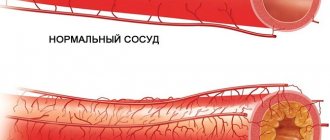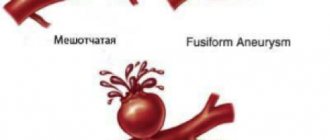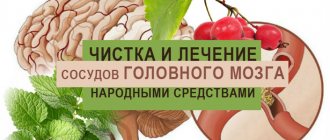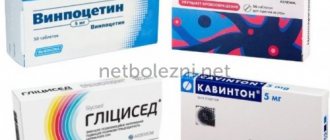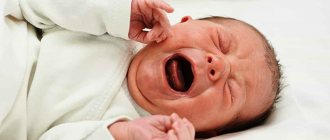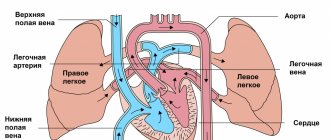What leads to vascular spasms
If previously the risk group included mainly elderly people, in recent decades the situation has changed. Air polluted with toxic substances, bad habits and a frantic pace of life do not pass without consequences - toxic microelements penetrate into the lungs and are transported to the brain, negatively affecting blood vessels.
Spasms represent a strong contraction of blood vessels. If left untreated, the pathology persists for a long time, and in advanced cases leads to a stroke.
The main cause of violations is an incorrect lifestyle
.
Doctors identify several other factors:
- chronic lack of sleep, combined with nervous and physical stress;
- hypothermia of the head;
- constant stress;
- alcohol and smoking abuse;
- excessive consumption of strong coffee, tea, energy drinks.
Vasoconstriction is observed in the following diseases:
Advertising:
- vegetative-vascular dystonia;
- violation of the integrity of the arteries;
- cervical osteochondrosis;
- vascular aneurysm;
- malfunction of the thyroid gland, heart and kidneys;
- benign or malignant tumors.
If a person has hypertension, dyscircular encephalopathy and diabetes mellitus, he is at risk.
If a person's parents or close relatives have suffered a stroke or heart attack, the likelihood of cerebral vascular spasms increases.
Discirculatory encephalopathy is a brain disease characterized by mental and neurological disorders. At the same time, the disease progresses steadily and can affect both individual parts of the brain and evenly affect the entire brain. Read more in the article: “Discirculatory encephalopathy of the 2nd degree.”
Why is high cholesterol dangerous?
Elevated cholesterol levels lead to the risk of developing coronary artery disease and myocardial infarction, ischemic stroke and gangrene of the extremities!
It is necessary to reduce the concentration of total cholesterol in the blood: a decrease in the concentration of total cholesterol in the blood by 10% leads to a reduction in mortality from heart disease by 20%. Little physical activity (physical inactivity), excess nutrition and smoking have a bad effect on cholesterol levels.
Physical exercise and weight loss reduce the concentration of cholesterol and triglycerides, thereby preventing the development of atherosclerosis.
Vasospasms: signs and clinical manifestations
Contraction of cerebral vessels is characterized by the following symptoms:
- Headache
. Localized at any point, are aching in nature, appear immediately after waking up or closer to night; - Meteor dependence
. Against the backdrop of changing weather, long-term pain intensifies, nausea and changes in general well-being appear; - Decreased cognitive (thinking) abilities
: attention, memory, performance, concentration. The listed processes are a consequence of lack of oxygen; - Noise in ears
. Unusual and unpleasant sounds appear during vascular spasms and intensify with significant physical exertion; - Feeling of pressure on the head
. The patient will feel as if his head is being “stuck in a vice.” There may be no pain, but the feeling that something is pressing on the head will remain for a long time.
Advertising:
The listed symptoms may also occur with other diseases. To establish an accurate diagnosis, consult a general practitioner, cardiologist and neurologist.
Diroton and Enalapril are common medications used for hypertension. Doctors recommend them to many patients as alternative treatments, but their effectiveness remains variable. Read more in the article: “Diroton or enalapril in the treatment of hepcinate LP.”
Features of headaches in cervical osteochondrosis.
Headaches (cephalgia) with cervical osteochondrosis are usually of moderate intensity. Patients characterize the pain as dull, pulling, boring, pressing (feeling of squeezing of the head). Cephalgia with osteochondrosis is usually paroxysmal in nature (from several hours to several days).
Most often, the pain is one-sided, localized in the cervical-occipital region and spreads to the frontal and temporal regions.
Headaches with cervical osteochondrosis are often accompanied by:
- photophobia (intolerance to bright light);
- phonophobia (increased sensitivity to sounds, noise);
- feeling of stuffiness in the ear;
- complaints of blurred vision.
Stiffness in the cervical spine and muscle tension are often noted. Pain and stiffness depend on the position of the neck, and intensify with tension in the muscles of the affected side, or with prolonged stay in an uncomfortable position.
Headaches with cervical osteochondrosis are often combined with pain in the shoulder and arm.
First aid for vascular spasms
To relieve vasospasm at home, follow a few simple tips:
- keep your feet in cold water for 3-4 minutes;
- wash your face with cold water;
- drink 20 drops of valerian or corvalol, then lie down until the pain subsides;
- dilute a tablespoon of honey in warm water and drink the mixture;
- Press on the temples and back of the head and gently massage the area in a circular motion.
If the pain persists for 2 days or more, consult a doctor.
Drug treatment
The main issues of concern to patients diagnosed with cerebral vascular spasms are symptoms, treatment and medications.
The main method of treatment for vascular contraction is a course of taking various medications.
We present to you a table with the main drugs that will help with vascular spasms.
Advertising:
| Name of the drug group | Medicines included in the category | Effect of use |
| Calcium antagonists | First generation of drugs: Finoptin, Isoptin, Cordafen, Cordipin, Diltiazem; Second generation: “Amlopidine”, “Nitrendipine”, “Nicardipine”, “Riodipine”, “Clentiazem”. Medicines that act directly on the blood vessels of the brain: Nimodipine, Cinnarizine. | Calcium antagonists are used to relax blood vessels. They increase blood flow and promote oxygen supply to the brain. Tablets in this category are used to treat diseases in the brain and the entire body. Effectively help with atherosclerosis of blood vessels. The new generation of drugs has an advantage over the previous one: their effect on the body is selective, side effects are minimized. |
| Medicines based on periwinkle | Vinpocetine is the most famous drug in the category. Other names of the drug: “Bravinton”, “Vero-Vinpocetine”, “Vincetin”, “Telectol”. | Periwinkle is a medicinal plant containing beneficial alkaloids. The latter have an antispasmodic effect, quickly relax large and small vessels, and improve metabolism in brain tissue. Medicines based on vinca alkaloids increase blood circulation and microcirculation, provide nerve cells with nutrients and prevent the formation of blood clots. |
| Preparations based on Gingko Biloba extract | “Ginkor Fort.” “Tanakan”, “Bilobil”, “Gingium”, “Gingko/gotu kola”. | Gingko Biloba is a medicinal herb that produces gingko extract. Based on it, complex medications are created that affect the blood vessels of the brain and its blood supply. The drugs relieve vascular spasm, thin the blood, have a positive effect on blood circulation, and normalize the permeability of the vascular wall. Medicines based on gingko biloba have a powerful antioxidant effect, strengthen the walls of blood vessels, and destroy free radicals. Under the influence of gingko extract, the metabolism of nervous tissue improves, and swelling disappears. |
| Products made from nicotinic acid | "Enduratin, "Nicotinic acid", "Nikospan". | Nicotinic acid dilates small vessels, normalizes, and strengthens the vascular wall. Taken under medical supervision. |
Before taking medications, be sure to consult your doctor, exclude contraindications and read the instructions.
Treatment of vascular spasm in a child
Advertising:
The contraction of blood vessels causes headaches in the child, impaired attention, and in advanced forms leads to mental retardation. Timely treatment will help avoid serious consequences. Therapy is medicinal in nature and is carried out using the following drugs:
- Vinpocetine
. Normalizes cerebral circulation, eliminates pain, tinnitus and dizziness. Administered intravenously under medical supervision; - Cavinton
. Indicated for angiospastic changes in the retina, headaches, hearing impairment and thrombosis associated with vascular disorders; - Artichoke syrup
. This is a herbal preparation prescribed to remove toxins from the child’s body. Used for auxiliary treatment in combination with other drugs.
With regular use of these remedies, improvement occurs within 7 days.
Treatment of spasms using traditional methods
Traditional methods of treatment are used for quick relief of symptoms or long-term therapy for vascular spasm. The effectiveness of traditional methods varies - the effect of drugs is individual. A large number of recipes will allow you to choose the best option that is suitable specifically for your body:
Advertising:
- Take plantain, dandelion root and St. John's wort flowers. Combine in equal proportions, put in a saucepan and boil for 15 minutes from the moment of boiling. Cool. Dip a bandage into the prepared mixture, tie it around your head and lie down for 15 minutes. The method is suitable for quickly relieving spasms and relieving severe headaches.
- Take 50 g of rose hips (fresh or dried), pour boiling water over it and keep on the stove for 1 hour. The prepared decoction can be consumed as tea 2 times a day. The composition reduces headaches and lowers blood pressure.
- Take garlic and thyme leaves (20 g each), brew and drink as tea for 2 months.
- Buy an aromatic pendant or aroma lamp. Pour jasmine or lavender oil into a special container and use it as aromatherapy.
When using folk remedies, pay attention to their composition.
Diagnostics
In search of the causes of pain or dizziness, the patient can contact doctors of various specialties: therapist, cardiologist, gastroenterologist, neurologist. To diagnose osteochondrosis, a comprehensive examination is required, which includes:
- radiography and computed tomography: effective only in the later stages of the disease, when changes become clearly visible;
- magnetic resonance imaging: thanks to a high degree of visualization, it allows you to see even initial changes; is currently the main diagnostic method;
- duplex scanning of the arteries of the head and neck: allows you to assess the quality of blood flow and identify vasoconstriction; used to determine the causes of headaches and dizziness.
It is mandatory to interview and examine the patient, determine areas of pain and the degree of mobility of the spinal column, and evaluate the quality of reflexes. For differential diagnosis with other diseases with similar symptoms, the following may be prescribed:
- ECG, ultrasound of the heart;
- daily monitoring of ECG and blood pressure;
- chest x-ray;
- consultations with specialized specialists: cardiologist, ENT specialist.
Make an appointment
Prevention of vascular spasms
Prevention of the disease consists of strengthening blood vessels. The latter is facilitated by a diet consisting of foods that maintain the natural elasticity of blood vessels and prevent the formation of blood clots. This includes vegetables, fruits, cereals, lean meats, legumes and cereals.
Advertising:
In addition to nutrition, preventive measures include:
- physical activity (moderate sports: running, swimming, aerobics and others);
- sufficient fluid intake;
- hardening the body and regularly taking a contrast shower;
- maintaining a stable state of the nervous system, eliminating stressful situations;
- correct daily routine (8-10 hours of sleep per day);
- minimizing the consumption of caffeinated drinks;
- quitting smoking and alcohol.
By following the above tips, you can speed up recovery and prevent relapse. It is not recommended to limit yourself to general measures; at the first symptoms, it is recommended to immediately consult a doctor to exclude new spasms.
Initial manifestations of insufficient blood supply to the brain (treatment, prevention, disability)
L. S. Manvelov, Candidate of Medical Sciences V. E. Smirnov, Doctor of Medical Sciences, Professor
Research Institute of Neurology of the Russian Academy of Medical Sciences, Moscow
The diagnosis of “initial manifestations of insufficiency of blood supply to the brain” (IPNKM) is established in accordance with the “Classification of vascular lesions of the brain and spinal cord” developed by the Research Institute of Neurology of the Russian Academy of Medical Sciences [4], if a patient with signs of a general vascular disease (vegetative-vascular dystonia, arterial hypertension (AH)) , atherosclerosis) there are complaints of headache, dizziness, noise in the head, memory impairment, decreased performance. Moreover, the basis for this diagnosis can only be a combination of two or more of the five listed complaints, which must be noted at least once a week for at least the last three months
The problem of prevention and treatment of early forms of vascular diseases of the brain is of great social and economic importance. Not only are they a serious risk factor for the development of cerebral stroke, one of the leading causes of disability and mortality, but they themselves significantly worsen the quality of life, and often reduce ability to work.
Secondary prevention, which is required by patients with initial manifestations of insufficiency of blood supply to the brain (IBC), includes measures to prevent both exacerbations of major cardiovascular diseases and vascular lesions of the brain.
Therapeutic and preventive measures for NPNCM can be schematically divided into the following types: work, rest and nutrition regimen; physiotherapy; diet, physio and psychotherapy; drug treatment and prevention. Most often, diet No. 10 is prescribed, taking into account anthropometric data and the results of a study of metabolic characteristics.
Treatment of patients with NPNCM should be carried out in three main areas:
- Impact on the mechanism of formation of insufficiency of blood supply to the brain,
- Impact on cerebral metabolism,
- Differentiated individual treatment depending on the clinical symptoms of the disease.
In patients with NPNCM in the early stages of the formation of the underlying vascular disease, rational employment, adherence to work, rest and nutrition regimens, cessation of smoking and alcohol abuse, and the use of drugs that increase the physiological defenses of the body are sometimes sufficient to compensate for the condition. In severe forms of the disease, complex therapy with extensive use of medications is necessary.
Therapy should be carried out aimed at eliminating foci of infection: odontogenic; chronic tonsillitis, sinusitis, pneumonia, cholecystitis, etc. Patients with diabetes mellitus should receive adequate antidiabetic treatment.
If treatment is not carried out regularly, the risk of developing acute cerebrovascular accidents, as well as dyscirculatory encephalopathy, increases significantly. Thus, according to our data, based on a seven-year prospective observation of 160 patients with hypertension with NPCCM (men 40-49 years old), transient cerebrovascular accidents (TCVA) developed 2.6 times more often, and cerebral stroke - 3.5 times more often in untreated patients. or those who were treated irregularly than those who were treated regularly and followed medical recommendations.
Drug methods of treatment and prevention of exacerbations of the underlying vascular disease
Vegetovascular dystonia. Therapy is carried out in accordance with the principles of dividing autonomic disorders according to sympathicotonic and vagotonic manifestations.
With increased sympathetic tone, a diet with limited proteins and fats, warm baths, and carbon dioxide baths are recommended. Central and peripheral adrenolytics and ganglion blockers are used. Alpha-blockers are prescribed: pyrroxan, redergin, dihydroergotamine, and beta-blockers: anaprilin, atenolol, tenormin, which have a vasodilating and hypotensive effect.
In cases of insufficiency of sympathetic tone, a diet rich in proteins is indicated; salt and radon baths, cool showers. Effective drugs that stimulate the central nervous system: caffeine, phenamine, ephedrine, etc. Improve the sympathetic activity of lemongrass tincture 25-30 drops per day, pantocrine - 30-40 drops, ginseng - 25-30 drops, zamanikha - 30-40 drops, calcium supplements (lactate or gluconate 0.5 g three times a day); ascorbic acid - 0.5-1.0 g three times; methionine - 0.25-0.5 g two to three times a day.
When parasympathetic activity increases, a low-calorie but protein-rich diet and pine baths (36°C) are recommended. They use drugs that increase the tone of the sympathetic system. Belladonna preparations, antihistamines, and vitamin B6 are used.
If the parasympathetic system is weak, the following have a positive effect: foods rich in carbohydrates; coffee; strong tea; low temperature sulfide baths (35°C). Increase parasympathetic tone with cholinomimetic drugs, cholinesterase inhibitors: prozerin 0.015 g orally and 1 ml of 0.05% solution in injections, mestinon 0.06 g, potassium preparations: potassium chloride, potassium orotate, panangin. Sometimes small doses of insulin are used.
Dividing the syndrome of vegetative-vascular dystonia by the nature of its manifestations (predominance of sympathetic or parasympathetic activity) is not always possible. Therefore, drugs that act on both peripheral parts of the autonomic nervous system and have both adrenergic and cholinomimetic activity have found widespread use in practice: belloid, bellaspon, ergotamine preparations.
Arterial hypertension. Therapeutic and preventive measures for hypertension should primarily be aimed at eliminating or correcting risk factors that contribute to the development of the disease, such as psycho-emotional stress, smoking, alcohol abuse, excess body weight, sedentary lifestyle, diabetes mellitus.
It is necessary to limit the consumption of table salt to 4-6 g per day (1/2 teaspoon), and in case of severe hypertension - even to 3-4 g.
Currently, five classes of antihypertensive drugs are considered the most effective for the drug treatment of hypertension: beta blockers, angiotensin-converting enzyme (ACE) inhibitors, diuretics, calcium antagonists and alpha blockers. The report of the WHO Expert Committee provides recommendations for the selection of the initial drug for the treatment of hypertension, presented in Table.
Complex antihypertensive drugs are effective: brinaldix, adelfan-ezidrex, trirezide K, etc. However, they have negative side effects of their ingredients: reserpine, thiazide diuretics and hydralazines. These drugs can be used during exacerbation of hypertension, but in the future it is necessary to select an individual maintenance treatment regimen. Therapy for the malignant form of hypertension should begin in a hospital.
Do not increase the dose of an initially effective drug multiple times if it no longer controls blood pressure reliably. If the prescribed medicine turns out to be ineffective, it needs to be replaced. It is better to add small doses of another antihypertensive drug than to increase the dose of the first one. The effectiveness of treatment increases when using the following combinations of drugs:
- A diuretic in combination with a beta blocker, alpha blocker or ACE inhibitor.
- A beta blocker in combination with an alpha blocker or a dihydropyridine calcium antagonist.
- ACE inhibitor in combination with a calcium antagonist. To achieve maximum results, in some cases it is necessary to use a combination of not only two, but also three antihypertensive drugs.
If in patients with moderate to severe hypertension, blood pressure does not decrease within a month of combined treatment with two or three drugs, it is considered to be resistant. The reasons for resistance are very diverse: irregular drug intake, insufficiently high doses, ineffective drug combinations, use of pressor drugs, increased blood plasma, the presence of symptomatic hypertension, excessive consumption of table salt and alcohol. The “white coat” effect is known (an increase in blood pressure in a patient in the presence of a doctor or nurse), which can create the impression of resistance. The most serious causes of treatment resistance are an increase in blood plasma in response to a decrease in blood pressure, kidney disease and drug side effects. In a number of patients with resistant hypertension, the use of loop diuretics, a combination of ACE inhibitors and calcium antagonists has a positive effect.
It is believed that the hypotensive effect is achieved with a persistent decrease in blood pressure in patients with mild hypertension (140-179/90-104 mm Hg) to a normal or borderline level (below 160/95 mm Hg), and with moderate and severe Hypertension (180/105 mm Hg and above) - by 10-15% of the initial values. A sharp decrease in blood pressure due to atherosclerotic lesions of the great vessels of the head, which occurs in 1/3 of patients with hypertension, can worsen the blood supply to the brain.
After selecting therapy, the patient is invited for examinations until an adequate reduction in blood pressure is achieved. This ensures that blood pressure is kept at an optimal level and risk factors are under control. A gradual and careful decrease in blood pressure significantly reduces side effects and complications of antihypertensive therapy.
When a stable decrease in blood pressure is achieved, the patient should be invited for repeated examinations at intervals of 3-6 months. Antihypertensive therapy is usually carried out indefinitely. However, after long-term adequate control of blood pressure levels, a careful dose reduction or discontinuation of one of the combined drugs is allowed, especially in individuals who strictly adhere to the recommendations for non-drug treatment.
Atherosclerosis. To treat patients with atherosclerosis, it is necessary first of all to identify high levels of serum cholesterol (CS) and take measures to correct it.
The main drugs used in the treatment of patients with NPNCM
A special role belongs to drugs that have a combined effect on blood supply and metabolism of the brain, as well as on central hemodynamics and rheological properties of blood. Cavinton (vinpocetine) 0.005 g is used; cinnarizine (stugeron) - 0.025 g; xanthinol nicotinate (teonicol, complamin) - 0.15 g; parmidine (anginine) - 0.25-0.5 g; sermion - 0.005-0.03 g; tanakan - 0.04 g - three to four times a day.
In cases of increased cerebral vascular tone in the spastic type of REG, antispasmodic and vasoactive agents are recommended. It is advisable to prescribe aminophylline 0.15 g three times a day. As a result, as a rule, the general condition of patients improves, headaches and dizziness decrease or disappear, and positive changes in rheographic and Doppler sonographic parameters are noted. Patients with unstable vascular tone are prescribed Belloid, Bellaspon, Grandaxin. For hypotension of cerebral vessels and signs of venous insufficiency, stimulating drugs are recommended: eleutherococcus, zamanikha, Leuzea rhizome, pantocrine, duplex, ginseng, tincture of Chinese lemongrass, aloe - and venotonic drugs: troxevasin, aescusan, anavenol, venoruton.
Due to the fact that vascular disease of the brain is often preceded or accompanied by cardiac dysfunction, patients are prescribed drugs that improve coronary blood flow, antiarrhythmics, and cardiac glycosides according to indications. For functional disorders of the heart in patients with NPCM, hawthorn in the form of a liquid extract, 20-30 drops four times a day, has a beneficial effect.
Currently, of the agents that have a positive effect on the rheological properties of the blood coagulation and anticoagulation system, aspirin is the best studied and most widely used. The main disadvantage of this drug is its irritating effect on the gastrointestinal tract. Therefore, it is recommended to take it once in a daily amount of no more than 1 mg per 1 kg of weight. For this purpose, trental 0.1 g, dipyridamole - 0.25 g and methindol - 0.025 g are also used three times a day. In addition, these agents prevent destabilization of the cell membranes of neurons during cerebral ischemia, suppress edema and swelling of the endothelium, increase blood flow to the brain, facilitate venous circulation and have an antispasmodic effect, which ultimately determines their effectiveness for secondary prevention and treatment of vascular diseases of the brain. A number of other drugs also have an antiplatelet effect: papaverine, no-spa, alpha- and beta-adrenergic blockers, etc.
For memory and attention disorders, to increase mental and motor activity, treatment with nootropil (piracetam) 0.4 g, encephabol (pyriditol) 0.1 g, aminalon 0.25-0.5 g two to four times a day is recommended , injections of Cerebrolysin 5.0 ml intravenously or intramuscularly and other means of similar action.
If there are manifestations of a neurosis-like syndrome, tranquilizers are prescribed: chlozepid (Elenium, Napoton) 0.005-0.01 g three to four times, sibazon (Seduxen, Relanium) - 0.005 g once or twice, phenazepam - 0.00025-0.0005 g and mezapam (rudotel) - 0.005 g two to three times a day; sedatives: preparations of valerian, motherwort, peony tincture, etc.
Of the methods of physical therapy, electrophoresis of drugs is most often used using the reflex-segmental (collar) transorbital Bourguignon method, as well as the general method of exposure in both the usual and bipolar ways. Favorable results were noted in treatment with electrophoresis of a 10% solution of acetylsalicylic acid and a 7.5-10% solution of potassium orotate from a 40-50% universal solvent - dimexide using a general method of exposure: longitudinally on the spine with application of electrodes to the collar , interscapular and lumbosacral areas - 8-12 procedures per course.
A new method of treatment is the electrophoretic administration of stugeron in the form of transcerebral reflex iontophoresis of a 0.5% solution. In patients with cephalgia, it is advisable to carry out three or four procedures of endonasal electrophoresis with a 0.1% dihydroergotamine solution before this.
For patients with impaired venous outflow, a method of transcerebral electrophoresis of a 5% solution of troxevasin has been proposed. The combined use of electrophoretic and oral administration of stugeron and troxevasin makes it possible to influence all parts of the vascular system of the brain: arterial tone, microcirculation and venous outflow.
For headaches and autonomic disorders, iodine electrophoresis is used using the collar method, and for neurotic conditions and hyposthenia, novocaine electrophoresis is used. Bipolar electrophoresis of iodine and novocaine is recommended for neurasthenic syndrome, a tendency to dizziness, and pain in the heart. For sleep disturbances and increased general excitability, electrophoresis of bromine and iodine, diazepam or magnesium according to the Vermeule method, and electrosleep are used. Electrophoresis of dallargin has a positive effect on the reflexogenic zones C-4 - T-2 and T-8 - L-2.
It should be emphasized that drug therapy has a number of limitations: side effects, allergic reactions, addiction to drugs, and a decrease in their effectiveness with long-term use. In addition, it is necessary to take into account the possibility of complete insensitivity of patients to a particular drug. Therefore, the use of non-drug treatment methods is of great importance.
Non-drug methods of prevention and treatment for NPNCM
The treatment complex includes diet therapy, active motor regimen, morning hygienic exercises, physical therapy, swimming in the pool, and sports games. If you are overweight, an underwater shower massage is performed. With concomitant osteochondrosis of the cervical spine - massage of the collar area.
Effects of alternating low-frequency magnetic fields and sinusoidal modulated currents on reflexogenic zones and muscle groups of the cervical, collar and waist areas, upper and lower extremities, taking into account daily biorhythms, are successfully used.
Reflexology methods are increasingly being introduced into practical healthcare: acupuncture, moxibustion, electroacupuncture, and exposure to laser radiation. In patients with NPNCM, as a result of treatment with these methods, the general condition significantly improves, subjective disorders decrease or disappear, there is a positive dynamics of REG and EEG indicators, which is explained by the normalizing effect of reflexology on metabolic processes, an increase in physical and mental tone, and the elimination of vegetative-vascular disorders. If the tone of the cerebral veins is increased, a course of microwave irradiation (8-12 sessions) is recommended for reflexogenic zones and acupuncture points.
Hyperbaric oxygenation is considered as a universal component of pathogenetic therapy for vascular diseases of the nervous system, which makes it possible to stabilize the pathological process, reduce treatment time and improve the prognosis. In the process of barotherapy, the general condition of patients, sleep, memory improve, asthenia, psycho-emotional disorders, headaches, dizziness, and autonomic disorders decrease.
A persistent clinical effect and long-term remissions were observed in patients with NPNCM who received complex treatment including hyperbaric oxygenation, acupuncture and physical therapy.
Widespread use of balneotherapy is recommended.
Hydroaeroionotherapy is used both as an independent method and in combination with other types of physiotherapy and medications. It is advisable to use oxygen therapy in the form of oxygen cocktails, which has a general stimulating effect and improves the functional state of the nervous system. The combination of aeroion therapy and oxygen therapy gives a greater clinical effect: well-being and memory improve, headaches disappear, vestibular and emotional-volitional disorders decrease. These treatment methods can be used not only in a hospital, but also in a clinic.
A method of training therapy using intermittent hypoxic exposure is proposed: inhalation of an air-nitrogen mixture containing 10% oxygen.
For neurosis-like syndrome, which is detected in a significant number of patients with NPNCM, psychotherapy is recommended. Its most important tasks are to develop in patients the correct attitude towards the disease, adequate psychological adaptation to the environment, and increase the effectiveness of medical and social rehabilitation. Psychotherapy involves the active participation of the patient in all its stages and should begin from the first appointment. In cases of severe manifestations of cerebrasthenia, hypnotherapy is successfully used. Using autogenic training is effective. The best results are achieved with combined treatment with tranquilizers and antidepressants with psychotherapy and autogenic training.
Of great importance is the complex step-by-step therapy of patients with NPNCM, which includes inpatient treatment, sanatorium-resort treatment and outpatient observation. Sanatorium-resort treatment is most appropriate to carry out in sanatoriums of the cardiovascular or general type, without changing the climatic zone, since due to a decrease in adaptive capabilities, patients with NPNCM spend significant time on acclimatization, which shortens the period of active treatment, reduces the durability of its effect, and in some cases even worsens the condition.
The main treating and dispensary doctor for patients with NPNCM should be a local (shop) general practitioner. The neurologist is assigned the responsibility of consultant to these patients. Clinical observation and course treatment, the duration of which is 1-2 months, should be carried out at least twice a year (usually in spring and autumn).
Work ability
Patients with NPNCM are usually able to work. However, sometimes they need easier working conditions, which are recommended by the VKK: exemption from night shifts, additional loads, correction of the work regime. Patients are referred to VTEK in cases where working conditions are contraindicated for them due to health reasons. They cannot work in a caisson, under altered atmospheric pressure, in hot shops (steelmaker, blacksmith, thermal operator, cook), under constant significant psycho-emotional or physical stress. If transfer to another job is associated with a decrease in qualifications, then disability group III is established.
| Choice of drug for the treatment of hypertension (according to WHO recommendations, Geneva, 1996) | |||
| Drug class | Indications | Contraindications | Limited use |
| Diuretics | Heart failure, old age, systolic hypertension, black skin color | Gout | Diabetes mellitus, hyperlipidemia, pregnancy*, increased sexual activity |
| Beta blockers | Angina pectoris, previous myocardial infarction, tachyarrhythmia, pregnancy | Bronchial asthma, obstructive pulmonary diseases, peripheral vascular diseases, heart block** | Hypertriglyceridemia, insulin-dependent diabetes mellitus, heart failure, athletic and physically active persons, black skin color |
| ACE inhibitors | Heart failure, left ventricular hypertrophy, previous myocardial infarction, diabetes with microalbuminuria | Pregnancy, bilateral renal artery stenosis | Black skin color |
| Calcium antagonists | Peripheral arterial disease, angina pectoris, old age, systolic hypertension, low glucose tolerance, black skin color | Pregnancy | Congestive circulatory failure***, heart block**** |
| Alpha blockers | Prostate hypertrophy, low glucose tolerance | Orthostatic hypertension | |
| * Due to a decrease in plasma volume. ** Atrioventricular blockades of the 1st and 2nd degrees. *** Either avoid or use with caution. ****Either avoid or use verapamil and diltiazem with caution. | |||
